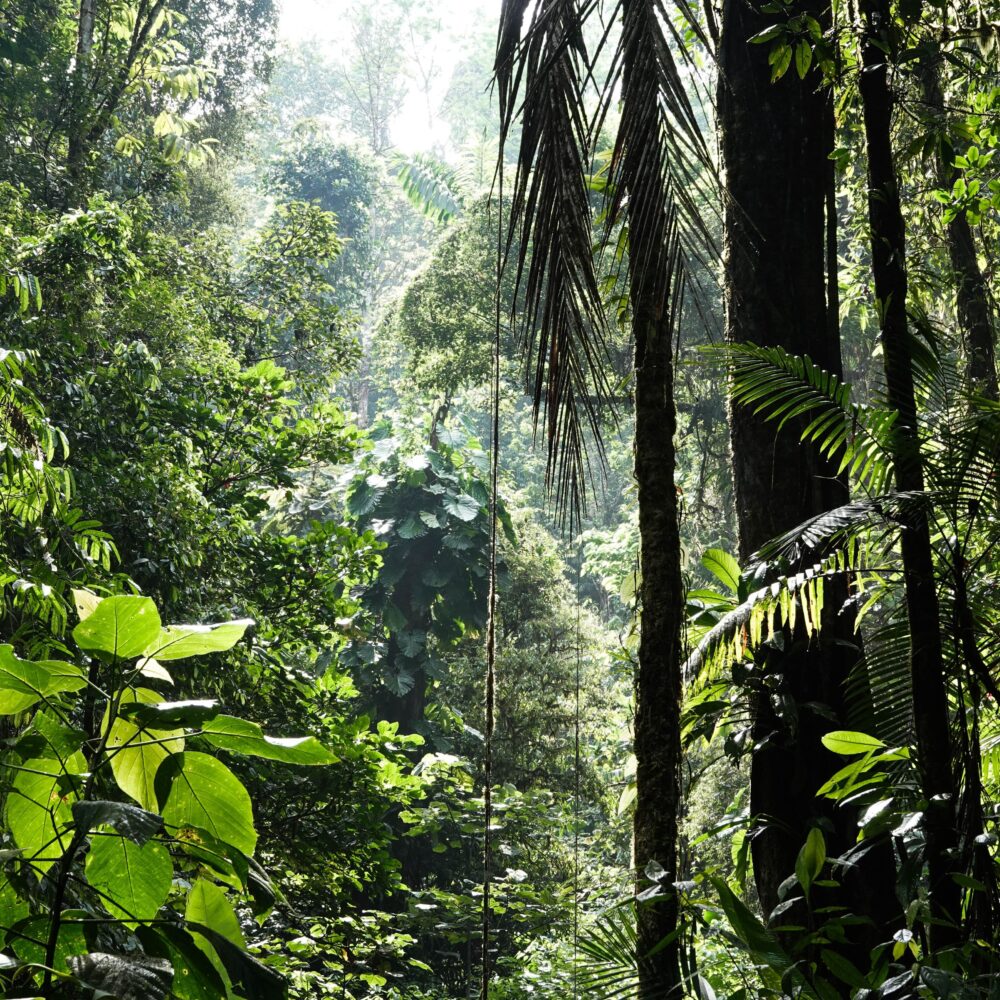
While forests may not always be at the forefront of your thoughts, they hold a critical role in our global ecosystem. Forests contribute significantly to maintaining the quality of the air we breathe, serve as habitats for diverse species, and have a substantial impact on climate regulation. However, the world's forests are currently facing a formidable challenge.
Deforestation, the widespread cutting down of trees, poses a substantial threat. It's akin to depleting the Earth's natural air filtration systems and disrupting the habitats of countless species. Fortunately, two strategies have emerged to address this issue: forest conservation and reforestation.
In this article:

Understanding Forest Conservation and Reforestation
Forest conservation is primarily focused on safeguarding existing forests by adopting practices that maintain their health and diversity. It involves protective measures, sustainable utilization, and the restoration of degraded forests without necessarily involving the extensive planting of new trees. On the other hand, reforestation specifically pertains to the deliberate act of planting trees in areas where they've been removed, with the goal of replenishing lost forest cover and rebuilding forest ecosystems.
Forest Conservation
Forest conservation refers to the careful management and sustainable use of existing forest areas. Its primary aim is to protect, maintain, and restore the health of forests, ensuring their long-term viability. This includes activities such as preventing deforestation, combating degradation, and promoting the overall well-being of forest ecosystems. The emphasis is on preserving the biodiversity, ecological balance, and the multitude of resources and benefits that forests offer.
Reforestation
Reforestation involves the deliberate and strategic replanting of trees in areas that have undergone deforestation or experienced a significant reduction in tree cover. This proactive approach aims to restore areas that were once forested but have been cleared due to human activities or natural events. The objective is to establish a new forest or regenerate the original forest ecosystem. Reforestation is a crucial component in mitigating the adverse effects of deforestation by reinstating lost habitats and ecosystem functions.


The multifaceted benefits of forests for our environment
The environmental benefits derived from forest conservation and reforestation are playing a vital role in the health and sustainability of our planet. Forests offer multifaceted advantages such as biodiversity conservation, climate change mitigation, water resource management, soil stability and air quality improvement.
Biodiversity Conservation and Habitat Preservation
Forest conservation and reforestation play a crucial role in preserving biodiversity and maintaining habitat integrity. Forests are home to approximately 80% of the world's terrestrial biodiversity. Conserving forests helps safeguard habitats and fosters ecological balance, supporting intricate relationships between species. Scientific findings reveal that undisturbed forests are reservoirs of genetic diversity, crucial for species' survival and adaptation to environmental changes. Protecting these habitats ensures the continuity of diverse ecosystems, which is fundamental for a healthy planet.
Carbon Sequestration and Climate Change Mitigation
Forests are pivotal in the global effort to combat climate change through carbon sequestration. Trees capture carbon dioxide from the atmosphere and store this in their branches. Studies show that forests worldwide absorb nearly 2.4 billion metric tons of carbon dioxide annually. Tropical forests alone store 25% to 40% of the world's carbon. By absorbing carbon dioxide, forests mitigate the impacts of climate change, acting as critical carbon sinks. Reforestation efforts further enhance carbon storage by planting new trees in areas that were previously deforested, aiding in climate change mitigation.
Water Resource Management and Watershed Protection
Another way in which forests play an important role, is managing water resources and protecting watersheds. Forests help regulate water cycles and maintain soil moisture. Research from the Food & Agriculture Organization indicates that forests directly contribute to clean and stable water supplies for approximately 75% of the world's accessible freshwater resources. Forested landscapes assist in preventing soil erosion, protecting watersheds, and ensuring downstream communities have consistent access to clean water. Studies indicate that the preservation of forests significantly contributes to water quality, benefiting both ecosystems and human communities.
Soil Erosion Prevention and Land Stability
Preserving forests and undertaking reforestation initiatives are crucial to curb soil erosion and sustain land stability. Research from the World Resources Institute (WRI) underscores the role of forests in anchoring soil, reducing erosion, and enhancing soil fertility. Protecting forests ensures the retention of topsoil, preventing erosion caused by wind or water. The stability of land and soil is crucial for supporting agricultural productivity, preserving natural landscapes, and safeguarding habitats for various species.
Air Quality Improvement and Pollution Control
Forests contribute to improved air quality and act as natural filters for air pollutants. The U.S. Forest Service indicates that forests in the United States alone remove around 17.4 million tons of air pollutants annually. Urban forests play a significant role in reducing air pollution in cities, contributing to the health and well-being of urban populations. Additionally, forests help combat climate change-related air pollutants by sequestering carbon dioxide.

Use synergy to strengthen ecological resilience
The collaboration between forest conservation and reforestation practices generates a powerful synergy, offering a combined impact that strengthens ecological restoration efforts. When combined, conservation and reforestation create a harmonious balance. Protected areas and conservation easements serve as foundational elements in this partnership, ensuring that designated zones remain untouched and maintain their biodiversity. These areas often act as seed sources for reforestation projects, facilitating the reintroduction of native flora and fauna into degraded or deforested landscapes.
Case studies further illuminate the success of this collaboration. For instance, the Atlantic Forest in Brazil has benefited from this synergy. Conservation initiatives protect existing forest fragments while reforestation efforts focus on connecting these fragments to restore a contiguous ecosystem. Similarly, projects in the Amazon Basin integrate conservation measures to safeguard primary forests and incorporate reforestation strategies in degraded areas, ultimately bolstering the overall health and resilience of the region's ecosystems. Such integrative strategies exemplify the potential of uniting conservation and reforestation to revitalize and protect our planet's precious landscapes.


International efforts and agreements
Paris Agreement
The Paris Agreement stands as a landmark global initiative in the fight against climate change, emphasizing the critical role of forest conservation and reforestation in achieving its objectives. Within the framework of the agreement, 195 nations have committed to curbing greenhouse gas emissions and advancing efforts to limit global temperature rise. Forest conservation and reforestation play a significant part in this endeavor.
The agreement recognizes the pivotal role that forests play in absorbing carbon dioxide from the atmosphere and emphasizes the need to enhance their preservation and restoration. By actively preserving existing forests and undertaking reforestation initiatives, countries can contribute to their nationally determined contributions (NDCs) outlined in the Paris Agreement, fostering sustainable practices that align with the broader goals of climate action and environmental stewardship on a global scale.
Sustainable Development Goals by the United Nations
The Sustainable Development Goals (SDGs) adopted by the United Nations provide a comprehensive framework to address global challenges and promote sustainable development across economic, social, and environmental sectors. Forest conservation and reforestation are deeply interwoven with the SDGs, specifically contributing to several key goals.
SDG 15, which focuses on life on land, directly relates to forest conservation and reforestation efforts. Protecting and restoring forests is fundamental to safeguarding biodiversity, ensuring sustainable land use, and promoting the conservation of ecosystems. Additionally, these initiatives substantially support SDG 13, which targets climate action. Forests serve as vital carbon sinks, aiding in the reduction of greenhouse gasses and mitigating the impacts of climate change. As countries aim to achieve their SDG targets, integrating forest conservation and reforestation measures becomes integral in advancing environmental sustainability and combating climate change.
Furthermore, forest conservation and reforestation align with various other Sustainable Development Goals. SDG 6 (Clean Water and Sanitation) emphasizes the role of forests in watershed protection, ensuring clean and accessible water sources. Reforestation aids in stabilizing soils and preventing erosion, directly contributing to SDG 2 (Zero Hunger) by supporting agricultural productivity and sustainable land use. Moreover, these initiatives also impact SDG 11 (Sustainable Cities and Communities) by improving air quality and creating green spaces within urban areas. The integration of forest conservation and reforestation practices into the SDGs amplifies their significance in fostering a sustainable future, highlighting their multi-dimensional impact on environmental preservation, socio-economic progress, and global well-being.

Will planting more trees save the environment?
Planting trees is a highly valuable environmental initiative with significant benefits for the planet, though it's essential to address some misconceptions that surround this practice. One common misconception is that planting trees is a simple, one-size-fits-all solution to complex environmental issues. While tree planting alone cannot fully resolve all environmental challenges, it remains a crucial part of a comprehensive strategy for mitigating climate change, preserving biodiversity, and enhancing ecosystem services.
Trees are potent carbon sinks, absorbing carbon dioxide during photosynthesis and storing it in their biomass. Therefore, reforestation and afforestation efforts have a substantial capacity to sequester carbon and mitigate climate change impacts. For instance, a study by the Swiss university ETH Zurich calculated that global tree planting could potentially sequester two-thirds of the carbon dioxide produced by human activity. This research underscores the immense potential of tree planting as part of a holistic approach to combat climate change.

Moreover, planting trees helps restore degraded landscapes, bolster biodiversity, and support ecosystem services. Trees provide habitats for diverse species, improve air quality, stabilize soil, regulate water cycles, and offer numerous social and economic benefits for communities. Reforestation projects, when executed thoughtfully and with consideration for local ecology, can have substantial positive impacts on both the environment and human well-being.
However, it's crucial to emphasize that tree planting must be done strategically, focusing on native species, diverse ecosystems, and suitable land use practices. This approach maximizes the ecological benefits of tree planting and ensures long-term success.
In conclusion, while tree planting is not a singular solution to environmental issues, it plays a critical role in combating climate change, preserving biodiversity, and improving ecosystem health. When integrated into comprehensive environmental strategies, tree planting stands as a highly valuable and impactful initiative for a healthier planet.

So, what’s next?
The environmental benefits of forest conservation and reforestation are profound and diverse. These initiatives serve as cornerstones in preserving biodiversity, mitigating climate change, managing water resources, preventing soil erosion, and improving air quality. From anchoring soil to acting as carbon sinks, from providing habitats for wildlife to regulating water cycles, the significance of forests in maintaining a balanced and thriving environment cannot be overstated.
However, the urgency for action cannot be ignored. As our planet faces escalating climate challenges and unprecedented biodiversity loss, the need to prioritize and implement forest conservation and reforestation efforts becomes increasingly critical. The scientific evidence overwhelmingly supports the positive impacts of these initiatives, yet these benefits can only be realized with swift and decisive action on a global scale. Immediate steps must be taken to protect existing forests, initiate reforestation projects, and uphold conservation efforts. The time for action is now, and the collective responsibility falls on individuals, communities, governments, and international bodies to preserve and restore our forests for the well-being of our planet and future generations. Embracing these actions not only secures a healthier environment but also ensures a sustainable legacy for generations to come.
